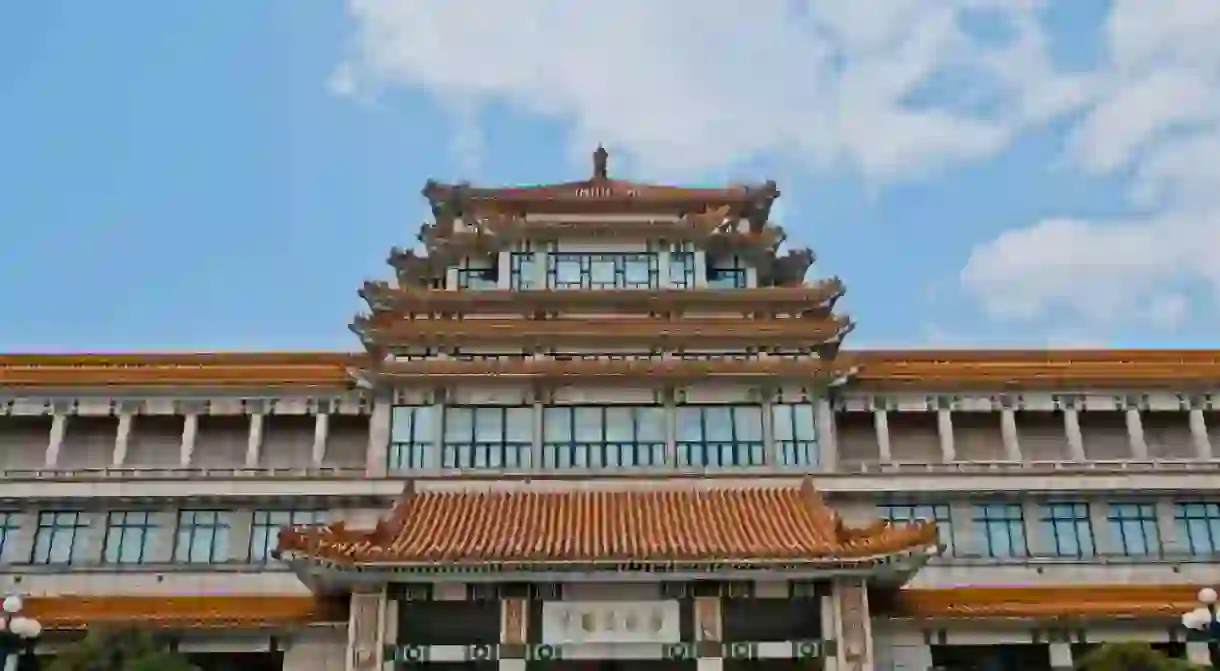The 10 Best Museums to Visit in Beijing

Including archaeology and cutting-edge technology, Beijing’s museums offer insights into traditional and contemporary Chinese culture. Here’s a round-up of the 10 best museums in Beijing.
National Museum of China
Art Gallery, Building, Museum

The National Museum of China is an eclectic art gallery located on Tiananmen Square in the very heart of Beijing. It exhibits a wide range of artefacts, arranged chronologically from the ancient era through to modern art. Established in 2003, the National Museum of China was born of a merger between two museums that occupied the two wings of the same building: The Museum of the Chinese Revolution and The National Museum of Chinese History. Visitors regularly have the chance to enjoy temporary exhibitions from museums around the world.
Beijing Folklore Museum
Museum
The Beijing Folklore Museum is housed in the city’s Dongyue Temple. Originally built in the 14th century as a temple for conducting rituals and ceremonies, today it attracts large crowds during major national celebrations, such as the Spring Festival and Mid-Autumn Festival. Of particular interest are the Taoist Departments of Death – chambers that await anyone who has done wrong in their earthly life – located in the temple, each inhabited by detailed and memorable statues of monks, spirits and demons.
Beijing Planning Exhibition Hall
Museum

The history of ancient Chinese cities can be traced back 4,000 years. The planning of these cities has, in itself, a rich and well-documented past that visitors can discover on a visit to the Beijing Planning Exhibition Hall. The exhibition hall, which opened in 2004, displays a detailed scale model of Beijing, along with a geographical model showing the mountains, rivers and roads around the city. If you opt for a two-hour audio tour, it will provide detailed information throughout the multiple exhibition areas, taking in Beijing’s past and plans for the city’s future development, looking ahead to Beijing as an eco-friendly city.
China Red Sandalwood Museum
Museum, Shop

Located in a wooden structure in the style of the Ming and Qing Dynasties, the China Red Sandalwood Museum was built with a private investment of ¥200 million (£23 million) and is the largest privately owned museum in China. It features artworks and models of ancient architecture, including the iconic traditional Chinese courtyards. The museum strives to promote the preservation of antique pieces of furniture, particularly those made of red sandalwood – a rare Chinese wood. For those inspired by the visit, the museum shop sells sandalwood souvenirs to take home.
China Science and Technology Museum
Building, Museum
Established in 1988, China’s only state-level science and technology museum has been steadily growing ever since, with a new exhibition building completed in 2009. There are five permanent exhibition halls and a number of short-term exhibits, along with laboratories, classrooms and lecture halls. As a very interactive venue, the museum is always a hit with kids. While its location is a little way out of the centre, it is close to the Olympic Village – combine a visit to both destinations for a great day trip.
National Art Museum of China
Building, Museum

Since its opening in 1958, the National Art Museum has dedicated itself to the collection of artistic works from across China. The large four-storey building features a plethora of paintings, sculptures, calligraphy and porcelain. Apart from the permanent exhibition, the museum plays host to visiting exhibits, which span the ages from classical to contemporary Chinese art.
China Nationalities Museum, Chaoyang
Museum, Park
Made up of 56 recognised ethnic groups, China is a mosaic of different cultures and identities. The China Nationalities Museum aims to share the country’s diverse cultures, housing exhibitions related to history, traditions and daily life. Here you can see more than 40,000 cultural relics, including production tools, musical instruments, traditional costumes and objects used in religious ceremonies.
Lu Xun Museum, Gongmenkou 2nd Alley
Museum
Considered by many to be the father of Chinese literature, Lu Xun was one of China’s visionaries at the turn of the 20th century. First trained as a medical scientist, he later abandoned his career to become a writer. He was a strong supporter of the May Fourth Movement, a student-led anti-imperialist movement, and promoted the use of vernacular Chinese through his work. Located in the writer’s former residence in Beijing, the Lu Xun Museum celebrates the writer’s achievements by displaying manuscripts and pictures from throughout his life. The museum also provides an insight into the main principles of modern Chinese literature.
Beijing Police Museum, Dongjiaomin Alley
Museum
A visit to the Beijing Police Museum may not be the most conventional choice of pastime when travelling through China, but this museum is more fascinating (not to mention entertaining) than you might expect. The museum’s collection includes tools and weapons that date back to the Han Dynasty while also tracing the history of forensics in China. An interactive experience, this museum even offers the chance to try your hand at a simulated car chase and laser shooting.
Paleozoological Museum of China, Xizhimen Outer Street
Museum
One of the largest museums of its kind in Asia, the Paleozoological Museum has an engaging collection of fossils, ancient life forms and human remains. One part of the museum is open to visitors while the other is used for research purposes. With a large display of fossils from now-extinct animals, the museum also explores the origin of humans and contains information on the Peking Man, an example of the “upright man”.












